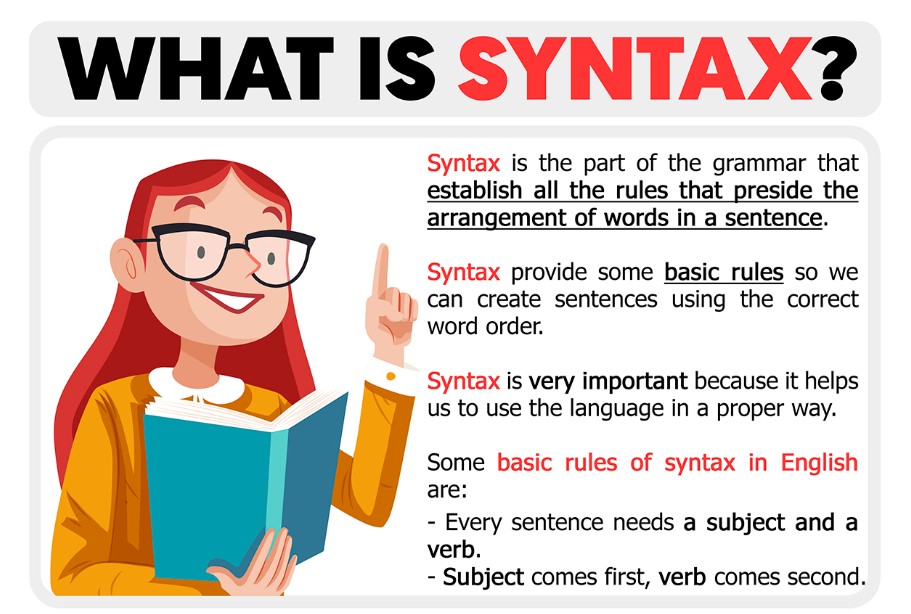
Imagine trying to convey a complex thought or idea, but the words are jumbled or out of order. It would be hard to understand, right? This is where syntax comes in. Syntax is the arrangement of words and phrases to create well-formed sentences in a language. It’s the invisible rulebook that dictates how words interact with each other to produce meaning. Whether in speech or writing, syntax plays a fundamental role in how we express ourselves and understand others.
When I first started studying language structure, I was fascinated by how the same group of words could convey entirely different meanings depending on their arrangement. A simple sentence like “I ate the cake” versus “The cake ate I” may contain the same words, but their meanings shift entirely due to syntax. This goes beyond just grammar; syntax is a key to clear, effective communication.
In this article, we’ll explore what syntax is, how it functions in different languages, and why it’s essential for conveying meaning. We’ll also look at how syntax differs across languages and the role it plays in making language both comprehensible and nuanced.
What is Syntax?

The Basics of Word and Phrase Arrangement
At its core, syntax is the set of rules, principles, and processes that govern the structure of sentences in a language. It defines how words and phrases are ordered to form well-structured and grammatically correct sentences. Without syntax, communication would be chaotic, and meaning would be lost.
Syntax isn’t just about word order—it’s about how different types of words (nouns, verbs, adjectives, etc.) function together in a sentence.
However, this structure can vary significantly across languages. While English uses SVO, other languages like Japanese use a Subject-Object-Verb (SOV) structure. The flexibility of syntax allows languages to express ideas in different ways while adhering to specific rules that speakers and writers follow to ensure clarity.
The Role of Syntax in Communication
How Word Order Influences Meaning
One of the most powerful aspects of syntax is its ability to shape meaning. A single sentence can express many different ideas depending on how the words are arranged. This isn’t limited to English; every language has its unique syntactical rules that determine how meaning is derived from a combination of words.
For instance, take the sentence:
-
“She gave him a gift.”
-
“She gave a gift him.”
While both sentences contain the same words, their meaning shifts because of the order in which they are arranged. In the first sentence, we know the subject (she), the action (gave), the recipient (him), and the object (gift). But in the second sentence, the meaning becomes unclear or awkward due to the improper arrangement of words. This shows how critical syntax is to maintaining clarity.
Furthermore, syntax also allows for emphasis and nuance. For example, the sentence “Only John ate the cake” emphasizes that John was the only person eating the cake, while “John only ate the cake” means that John ate the cake but did not do anything else. Small changes in word order can thus significantly change the message being conveyed.
Syntax in Different Languages
How Word Order Varies Across Cultures
While all languages have syntax, the rules governing word order and sentence structure vary significantly across cultures. In English, as mentioned earlier, we follow a Subject-Verb-Object order, but other languages may use different structures. Let’s explore some examples:
-
Japanese (SOV): In Japanese, the sentence “I ate sushi” would be structured as “I sushi ate” (私は寿司を食べた). The subject comes first, followed by the object and then the verb.
-
German (SVO): Like English, German follows an SVO order for main clauses, but its syntax becomes more flexible in subordinate clauses, where the verb often moves to the end of the sentence. For example, “I eat sushi” becomes “Ich esse Sushi,” but “I think that I eat sushi” would be “Ich denke, dass ich Sushi esse.”
-
Arabic (VSO): In some forms of Arabic, the typical order is Verb-Subject-Object (VSO). So, “I ate sushi” would be structured as “Ate I sushi.”
These differences highlight the fluidity of syntax across languages and the variety of ways in which people around the world express the same idea. In some languages, word order is more flexible, and meaning can be inferred from context or markers like verb conjugations or case markings on nouns.
The Importance of Syntax in Writing
Enhancing Clarity and Style
In writing, syntax is vital for not only clarity but also style. The way we structure our sentences can have a profound impact on the effectiveness of our communication. Writers use syntax to craft persuasive arguments, evoke emotions, and engage readers. Consider how syntax can affect tone and rhythm:
-
Short, Simple Sentences: Short sentences often have a punchy, direct effect. “She ran. She screamed.” These sentences can create urgency or drama.
-
Complex Sentences: More complex sentences, with multiple clauses and phrases, can provide depth and complexity to writing. “Although she was tired, she ran to the end of the street and screamed for help.”
-
Pacing and Flow: The way words are arranged within a sentence can also influence pacing and flow. A writer may choose to use a variety of syntactical structures to keep the reader engaged or to emphasize particular points.
Effective use of syntax can turn an ordinary statement into something compelling or persuasive. It’s an essential tool for both clarity and creative expression in written communication.
Common Syntax Errors and How to Avoid Them
Tips for Using Syntax Correctly
While syntax is essential for clear communication, it can be easy to make mistakes, especially in a language like English where exceptions and rules abound. Here are some common syntax errors and tips on how to avoid them:
-
Sentence Fragments: A sentence fragment occurs when a group of words is missing a subject or a verb, making the sentence incomplete. For example, “When we arrived at the party.” This needs to be corrected to “When we arrived at the party, everyone was dancing.”
-
Comma Splices: A comma splice happens independent clauses are joined with just a comma, without a coordinating conjunction or semicolon. For instance, “I love reading, I go to the library every weekend.” This can be fixed by adding a conjunction: “I love reading, and I go to the library every weekend.”
-
Misplaced Modifiers: it can confuse the meaning of a sentence. For example, “She almost drove her kids to school every day” might suggest she didn’t quite drive them. It’s clearer to say, “She drove her kids to school almost every day.”
By focusing on proper syntax, we can ensure that our writing remains clear, effective, and easily understood by readers.
Conclusion: Syntax—The Backbone of Language
Syntax is the foundation upon which language is built. It dictates how words and phrases are arranged to form meaningful and grammatically correct sentences. Whether in writing or speech, syntax allows us to communicate ideas clearly, convey emotions, and share knowledge. Understanding and mastering syntax is essential for anyone looking to improve their writing, enhance their communication, or simply appreciate the intricacies of language.
By paying attention to how words interact and ensuring that they’re arranged correctly, we can achieve clarity and precision in our language, and even explore the beauty and creativity that syntax allows in storytelling. So the next time you write or speak, think about how your sentences are structured—because the right syntax can make all the difference in how your message is received.







